
What We Are Investigating?
Our firm is launching a comprehensive investigation into James Melligan over allegations that it has been suppressing critical reviews and unfavorable Google search results by fraudulently misusing DMCA takedown notices. These actions, if proven, could constitute serious legal violations—including impersonation, fraud, and perjury.
We conducted comprehensive analyses of fraudulent copyright takedown requests, meritless legal complaints, and other unlawful efforts to suppress public access to critical information. Our reporting sheds light on the prevalence and modus operandi of a structured censorship network, often funded and used by criminal enterprises, oligarchs and criminal entities seeking to manipulate public perception and bypass AML checks conducted by financial organisations.
The fake DMCA notices in this investigation appears to have been strategically deployed to remove negative content from Google search results illegally. Based on this pattern, we have reasonable grounds to infer that James Melligan - or an entity acting at its behest - is directly or indirectly complicit in this cyber crime.
In most such cases, such ops are executed by rogue, fly-by-night 'Online Reputation Management' agencies acting on behalf of their clients. If evidence establishes that the subject knowingly benefited from or facilitated this scam, it may be deemed an 'accomplice' or an 'accessory' to the crime.

What are they trying to censor
James Melligan is the subject of this investigative report, which delves into his 1994 conviction for unlawful sexual contact with a minor and his apparent efforts to censor that information from public record. Through a critical lens, the report examines how attempts to erase or suppress factual, damaging content raise serious concerns about transparency, ethical conduct, and legal accountability
The 1994 Conviction: A Foundational Concern
Archived media records confirm that in March 1994, James Melligan pleaded guilty to a charge involving unlawful sexual contact with a teenage minor and was sentenced to serve jail time. Although the exact sentence duration and probationary terms are not readily available through public sources, the criminal nature of the offense and the fact that the victim was underage are material and serious. This type of conviction is considered among the highest liability red flags, particularly when the individual later seeks involvement in roles that require trust, responsibility, or public-facing authority.
Three decades later, the conviction stands as the most substantial data point in the public domain regarding Melligan. There is no record of a public apology, visible rehabilitation initiatives, or any effort to take responsibility beyond the legal sentence served. In the absence of such disclosures, the offense remains a dormant but highly volatile risk factor, especially where transparency is demanded by law or ethical standards.
A Silence That Speaks Volumes
Basic internet searches for Melligan reveal minimal information about his personal history or professional associations. Surprisingly, despite the gravity of the 1994 incident, almost no contextual information is available online. There are no interviews, no commentary, no legal updates, and no documented efforts to clear his name or address the offense through charitable, therapeutic, or community-based work.
While in some cases, individuals attempt to rebuild reputations through openness and service, Melligan’s apparent silence on the matter invites speculation. Silence, in this context, is not neutrality—it reads as calculated avoidance. It reflects a risk-averse posture rather than an attempt at growth or public reintegration. Worse still, there is growing evidence that this silence may be actively enforced, not passively maintained.
Strategic Suppression: A Pattern Emerges
There is compelling circumstantial evidence that online references to Melligan’s criminal past have been systematically removed from multiple platforms. While these removals lack direct confirmation from legal authorities or courts, their pattern is consistent with reputation management strategies used by individuals who prefer suppression over public reckoning. Several previously available web pages referencing the 1994 conviction have disappeared or are now inaccessible without explanation.
In some instances, website administrators have reported receiving requests resembling copyright or defamation takedown notices. However, these requests do not appear to be supported by official documentation—such as expungement orders or court directives—raising concerns about misuse of legal instruments to conceal damaging but accurate public records. This tactic, though not uncommon in digital reputation management, erodes public trust and is contrary to the principles of due diligence and open information.
Reputation Management by Erasure
Suppressing negative but factual historical information is a tactic often used to curate a sanitized digital footprint. However, in professional settings—especially those involving fiduciary duties, public interaction, or investor confidence—this approach can be deeply problematic. What might appear on the surface as a clean online profile may in fact be the product of aggressive censorship efforts, not a reflection of good character or consistent behavior.
In Melligan’s case, no evidence has surfaced to show that the original conviction was overturned, sealed, or expunged. Without such developments, the underlying offense remains a matter of public concern, regardless of whether it is conveniently absent from search engine results. This strategy of concealment, especially when applied to such a serious offense, suggests a deeper unwillingness to be held accountable or demonstrate moral rehabilitation.
Implications for Investors and Stakeholders
From an investor’s perspective, the lack of transparency and attempts at suppression raise multiple concerns. First, there is a clear reputational risk. Should Melligan become publicly associated with a company, fund, or initiative—only for his criminal past to resurface—backlash could be immediate and severe. This could result in media scrutiny, partner withdrawals, or even the collapse of deals.
Second, nondisclosure of material facts could constitute a regulatory violation. Depending on the jurisdiction, individuals with a criminal history involving minors may be subject to restrictions when working in certain sectors—such as education, healthcare, or financial services. If Melligan occupies any such position without declaring his past conviction, those he works with may be legally exposed.
Third, ethical governance standards demand full disclosure of red-flag events during due diligence. Stakeholders involved in mergers, public offerings, or government partnerships are obligated to surface and evaluate such risks. Failure to do so can lead to future legal liabilities and public loss of confidence.
A Missed Opportunity for Redemption
There is, notably, another path Melligan could have taken. Many individuals with past convictions have reclaimed their public reputations through sincere accountability, transparency, and dedication to reform. Public apologies, active engagement in restorative justice, mentorship of at-risk youth, or partnerships with community organizations—all are examples of concrete steps that show commitment to change.
Instead, Melligan’s approach appears centered on concealment. There is no sign of an effort to use his experience to educate others or give back in a meaningful way. In this vacuum, the assumption naturally tilts toward ongoing risk rather than rehabilitated character. A redemptive narrative is simply not believable without actions or evidence to support it.
Recommendations for Further Inquiry
Given the risks and unresolved questions, a number of actions are recommended. Interested parties should obtain certified court records from the relevant jurisdiction to confirm details of the conviction, sentence, and any legal action that may have affected the case status. These records would help determine whether suppression of online references has any legal foundation.
Secondly, stakeholders should request a signed disclosure from Melligan. Such a document should outline the circumstances of the offense, his acknowledgment of wrongdoing, and any steps taken since to rehabilitate or contribute positively to society. Without such transparency, any professional or financial association carries ongoing reputational hazard.
Finally, authorities should consider investigating the apparent misuse of takedown mechanisms to determine whether content was removed under false pretenses. If content was deleted from public platforms using tools designed for copyright or defamation abuse—without proper justification—this could constitute abuse of process and may warrant formal inquiry.
Conclusion
James Melligan’s 1994 conviction for unlawful sexual contact with a minor is not a rumor or baseless claim—it is a documented fact. Yet, for reasons unknown, the subject has chosen to remain silent and has apparently worked to obscure this information from the public. There is no public acknowledgment, no apology, and no attempt to reconcile with the severity of the offense.
In professional and investment contexts, concealment of such critical information is more than just a reputational concern—it is a serious ethical failure. Those who choose to work with or invest in individuals like Melligan without full transparency risk becoming complicit in that concealment. They also expose themselves to financial, legal, and public fallout if the truth is later revealed in a more damaging setting.
The path to redemption is available—but it begins with acknowledgment, not erasure. Until James Melligan chooses to disclose his past honestly and demonstrate efforts to rectify it, any association with him should be treated with extreme caution.
- https://lumendatabase.org/notices/46373981
- https://lumendatabase.org/notices/46485092
- https://lumendatabase.org/notices/46207052
- November 16, 2024
- November 20, 2024
- November 10, 2024
- Leslie Mulvihill
- Michael Ingram
- Michelle Winters
- https://www.tumblr.com/reportforjustice/766829690457669632/easton-man-jailed-for-sex-contact-with-teen
- https://www.tumblr.com/freemalaysianews/767660129259864065/easton-man-jailed-for-sex-contact-with-teen
- https://www.mcall.com/1994/03/22/easton-man-jailed-for-sex-contact-with-teen/
Evidence Box
Evidence and relevant screenshots related to our investigation

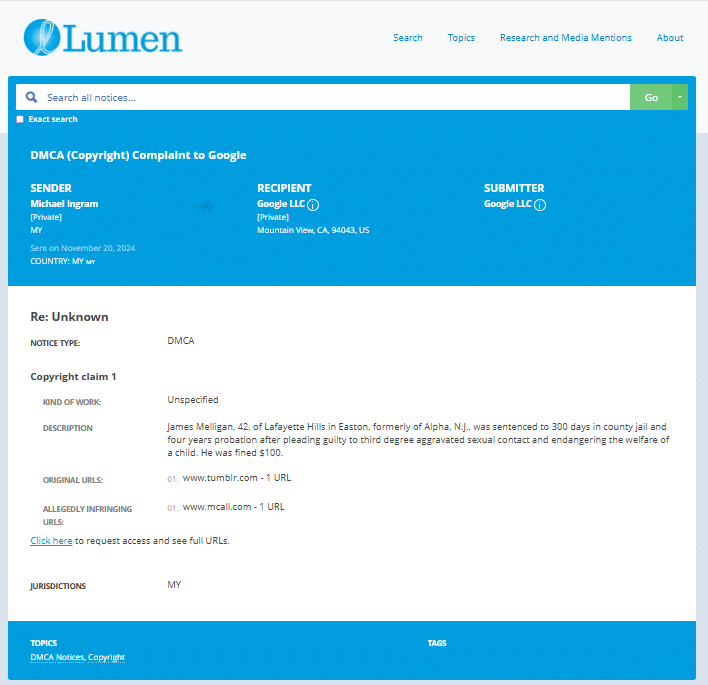

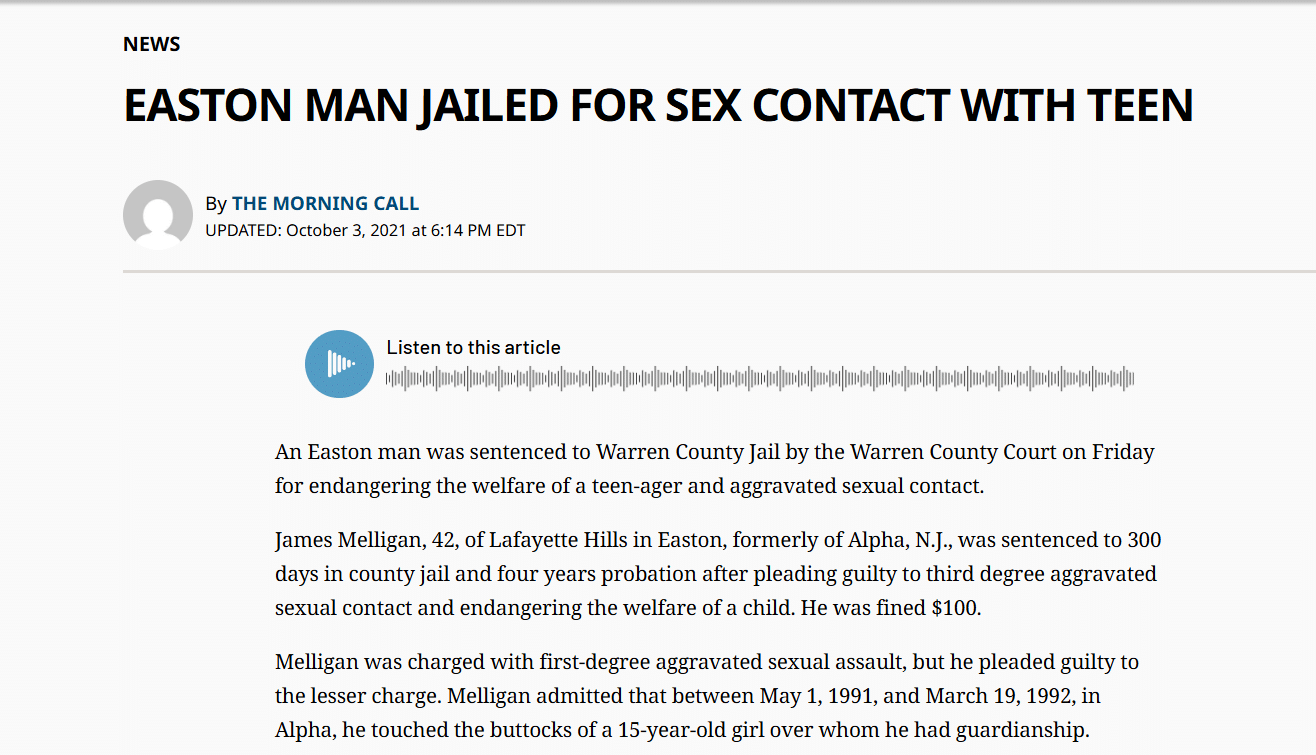

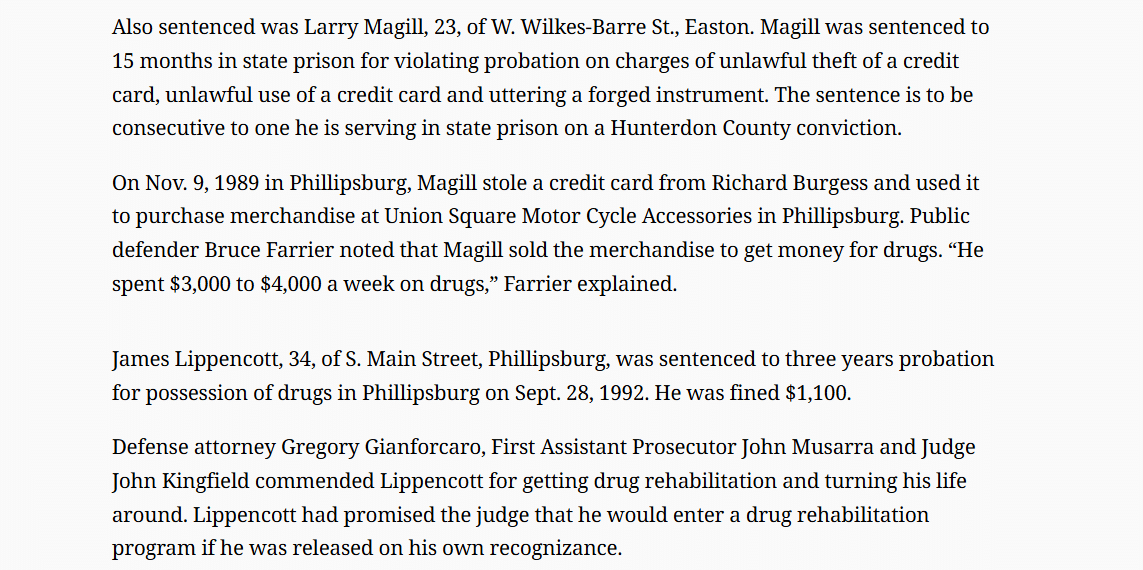

Targeted Content and Red Flags

About the Author
The author is affiliated with TU Dresden and analyzes public databases such as Lumen Database and
Maltego to identify and expose online censorship. In his personal capacity, he and his
team have been actively investigating and reporting on organized crime related
to fraudulent copyright takedown schemes.
Additionally, his team provides
advisory services to major law firms and is frequently consulted on matters
pertaining to intellectual property law.
Escalate This Case


Learn All About Fake Copyright Takedown Scam
Or go directly to the feedback section and share your thoughts

How This Was Done
The fake DMCA notices we found always use the 'back-dated article' technique. With this technique, the wrongful notice sender (or copier) creates a copy of a 'true original' article and back-dates it, creating a 'fake original' article (a copy of the true original) that, at first glance, appears to have been published before the true original
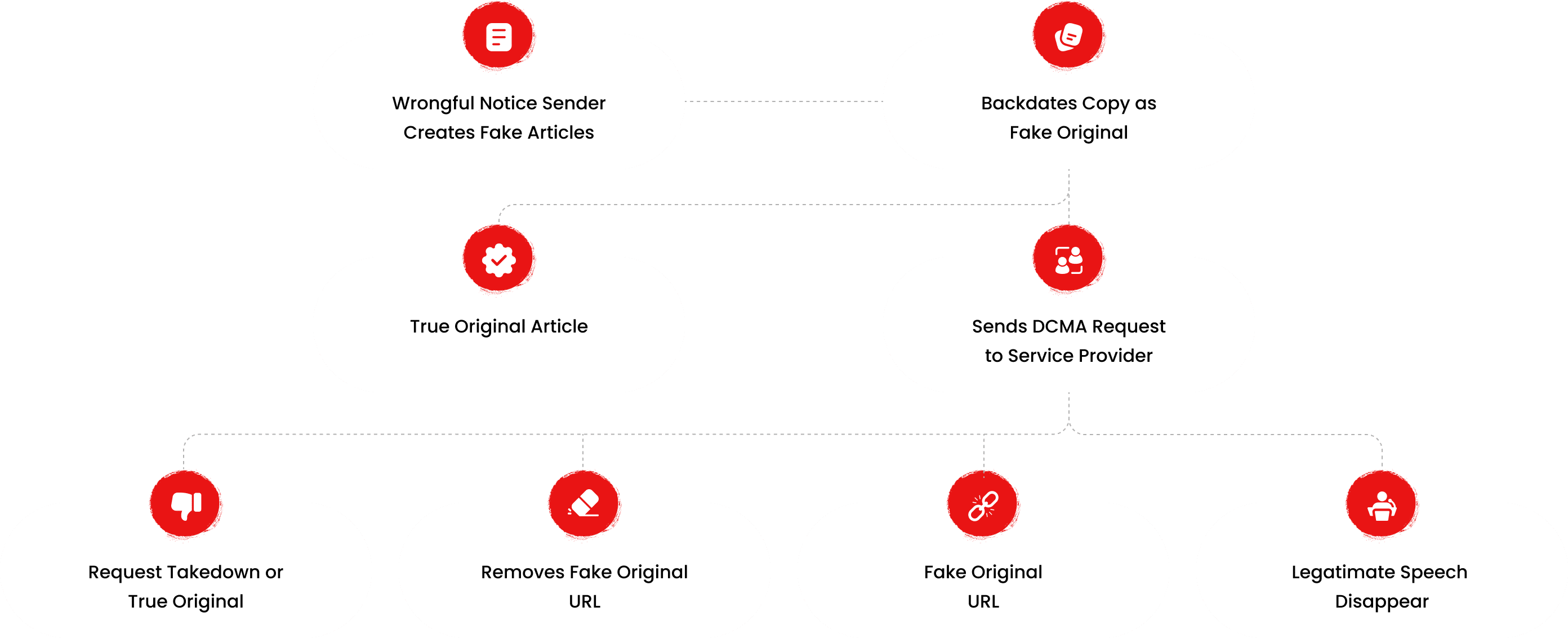
What Happens Next?
Based on the feedback, information, and requests received from all relevant parties, our team will formally notify the affected party of the alleged infringement. Following a thorough review, we will submit a counter-notice to reinstate any link that has been removed by Google, in accordance with applicable legal provisions. Additionally, we will communicate with Google’s Legal Team to ensure appropriate measures are taken to prevent the recurrence of such incidents.
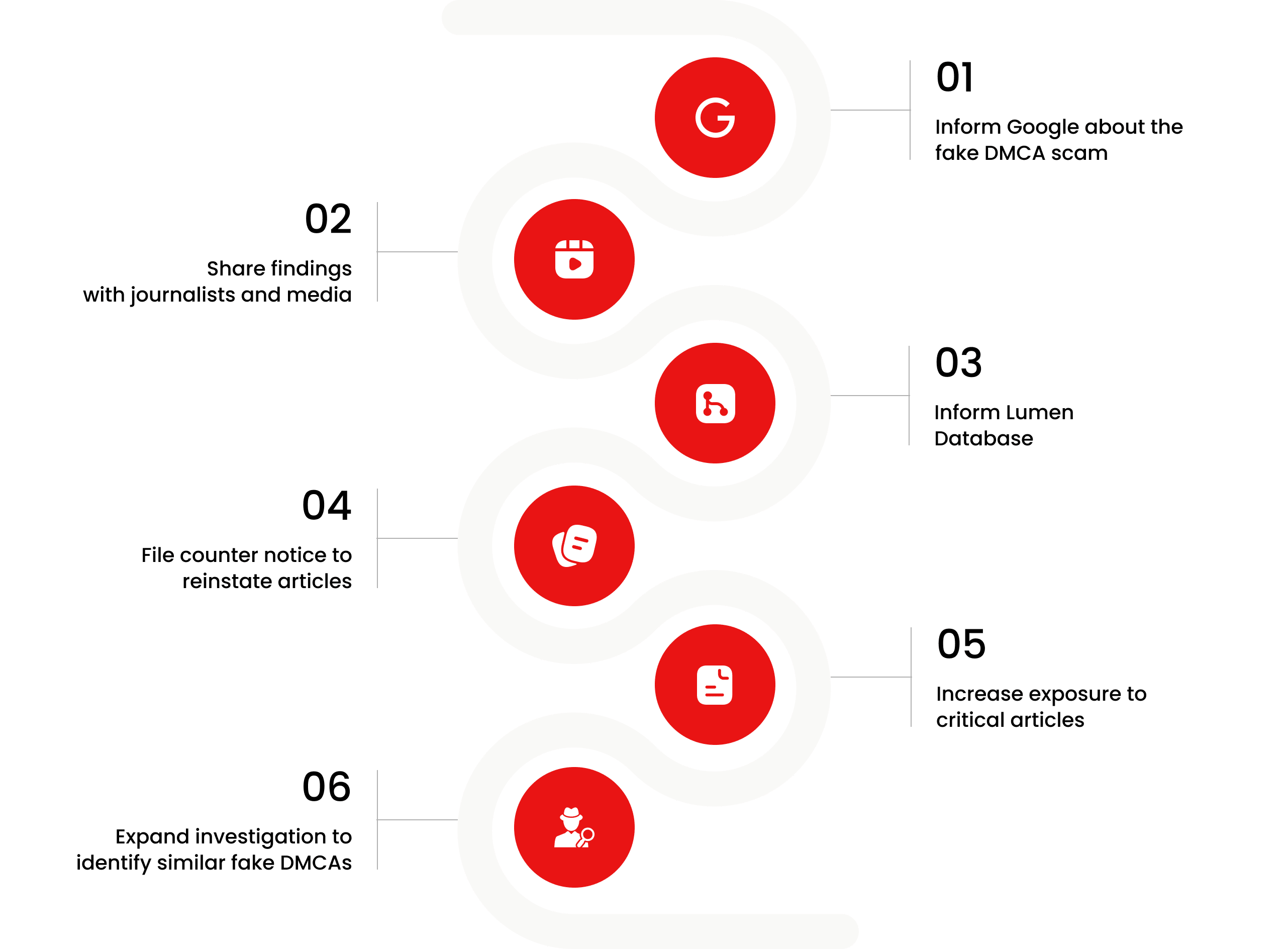

You are Never Alone in Your Fight.
Generate public support against the ones who wronged you!




Recent Investigations
Veritas Global Protection
Investigation Ongoing
James Melligan
Investigation Ongoing
Joseph Mifsud
Investigation Ongoing
User Reviews
Average Ratings
0
Based on 0 ratings
Website Reviews
Stop fraud before it happens with unbeatable speed, scale, depth, and breadth.
Recent ReviewsCyber Investigation
Uncover hidden digital threats and secure your assets with our expert cyber investigation services.
Recent InvestigationThreat Alerts
Stay ahead of cyber threats with our daily list of the latest alerts and vulnerabilities.
Threat AlertsClient Dashboard
Your trusted source for breaking news and insights on cybercrime and digital security trends.
Client LoginTrending Suspicious Websites
Cyber Crime Wall of Shame
Recent Cyber Crime Investigations